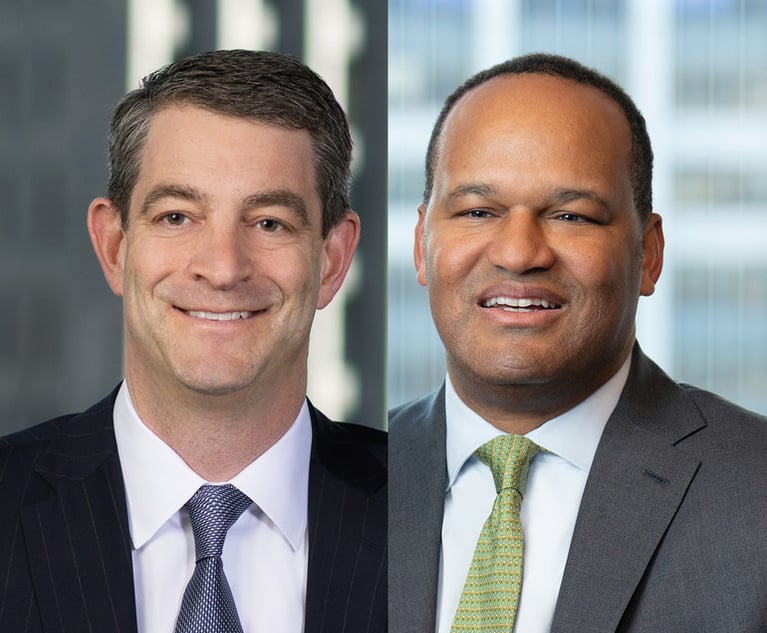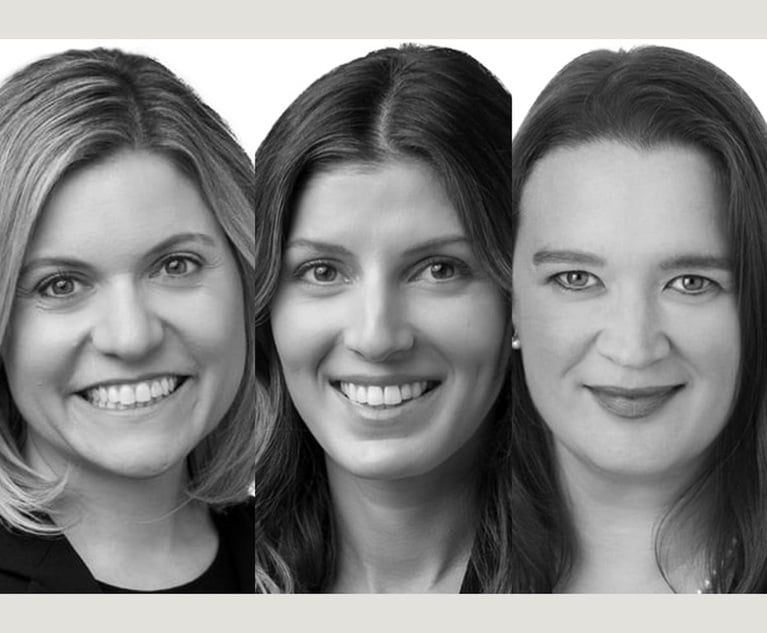Which Disconnects Are Holding Your Firm Back?
A series of marketing-related gaps and mismatches are limiting many firms.
March 28, 2019 at 03:00 PM
8 minute read

When I started to write the book “Best Practices in Law Firm Business Development and Marketing,” I set out to find those rainmakers, general counsel, law firm leaders and marketers who exemplified the very best practices in law firm management and marketing. I had spent the last 14 years as the chief marketing officer of Cravath, Swaine & Moore, and before that I held a similar post at Debevoise & Plimpton, but I knew that even with that experience behind me, there was more for me to learn.
After conducting more than 60 interviews and meeting with leaders throughout the country and in London, several themes and lessons emerged. Some of the most interesting ones are what I call disconnects. These were the mismatches that appeared when certain views or facts just didn't match up. I went back after conducting interviews, comparing my notes from one talk to another, and saw patterns begin to appear. While these disconnects may be seen as impediments to law firms, for those that move decisively in how they operate and market, they may be opportunities. There are a number of firms that are already successfully moving in that direction.
What Clients Want and What Law Firms Deliver
Think about coffee drinkers. Consider a large group of potential coffee consumers who want to drink crème brûlée lattes, but regardless of which chain they go to—Dunkin Donuts, Starbucks or McDonalds—none offers it. These popular spots carry a range of coffee, and their advertising jingles tell customers that America can't run without it; but unless they carry the drink that CBL drinkers want, there is an unmet need.
Now consider that a small chain is launched: the Crème Brûlée Latte Shoppe. At first, they sell just CBLs and the customers in search of CBLs are hooked. And a few months later, the same customer may consider ordering a scone or a donut at the CBL Shoppe. After all, they are happy with the CBL Shoppe's service, and they like the coffee product. Why not try their other offerings? After a while, the customers move away entirely from Dunkin Donuts, Starbucks and McDonalds, and fulfill all of their coffee and snacking needs at the CBL Shoppe.
This is much of what is happening within the legal profession and describes the opportunities for those who fill a niche. At first, it may just mean that there is a window of opportunity. Perhaps it's an accounting firm or a legal process outsourcing company that offers a solution for a specific legal need. Eventually this may lead to strong relationships with clients and further encroachment into the market. Law firms need to decide if they want to be part of filling these needs upfront, or instead be on the defensive once other entities enter their space. Another option is collaboration, working with LPOs and other types of companies to find creative solutions to fill the void.
Allen & Overy worked hand in hand with Deloitte to create MarginMatrix, a tool that allows them to help clients address a regulatory challenge regarding derivative compliance. Rather than be intimidated by a challenge facing their clients, they looked for a creative and new solution, even if it meant bringing in outside expertise.
Garnering customer feedback is required in any type of business, but like many management tools, this one arrived late to law firms. However, it's clear from all of the surveys firms conduct that clients are clamoring not just for legal resolutions but for greater efficiency and greater value on all of their matters. Yet, there still remains a disconnect between what clients want and what firms generally deliver. Whether it means a diverse partnership or better pricing, today's clients often look askance at law firms' promises. They want substance, not platitudes.
It's clear that, on the whole, law firms are not adapting as fast as many of their counterparts in the legal space: the LPOs and accounting firms. In the meantime, corporate legal departments continue to look at all kinds of alternative scenarios. Altman Weil's 2018 Chief Legal Officer Survey showed many GCs are bringing more work back to their own legal departments, increasing their own department's hiring.
What Marketers Can and Are Allowed to Do
Marketing for law firms was a new profession back in the 1980s, and there were few people involved, but now it's a mature discipline full of professional marketers. There are more than 3,900 members of the Legal Marketing Association. Today's law firm marketers often have backgrounds in law, finance, research and branding. Yet, there remain law firm leaders who do not take advantage of the talent that sits inside their offices. They believe that their marketing department is adequate for putting together pitch materials, but not for working hand in hand on strategy or developing new avenues of business.
➤➤ Listen to Deborah Farone discuss lessons in law firm marketing and business development on the latest episode of Law.com's Legal Speak podcast. Click here.
According to a 2018 Calibrate/ALM Legal Intelligence report, most CMOs report to the firm's managing partner. Yet still there remain firms where the CMO reports to a large committee or group of marketing partners, many without marketing or management experience. During my research, I found that the best marketing functions appeared to be the ones where marketers are truly entrenched in the practice areas, and where they report to the leadership of the firm. These marketers are included in partner meetings and kept active in the firm's management.
Access is not only important to the CMO role; it's equally important to those embedded in the practices. The more exposure they have to the practice area and industry, the better they are able to help the partners. For “Best Practices,” Dechert CEO Henry Nassau spoke to me about the marketing manager who helps his industry group, stating in glowing terms that she had a true grasp of what the lawyers at the firm do and “lives and breathes” the business. This is a sign of a firm that takes a serious approach to practice management.
Technology Confusion
There is an explosion of new technology in both business operations and client development. Many firms are swimming around without a life jacket looking at the new tools or bringing them on board without a real mission. By doing so, they are missing key lessons. The best firms are involving lawyers and marketers within the practices and truly understand what problems they are aiming to solve, rather than looking at technology for technology's sake.
There is a big disconnect between firms and their understanding of what technology can do for them. This lack of understanding often comes into play whether working with a legal service company, such as Integreon Inc. or UnitedLex, or newer technologies that can be put to use as an enterprise solution at law firms, such as OnePlace or Foundation. Rather than avoid these technologies, smart firms are utilizing these services and thinking creatively about how to apply or create innovation at their own firms. I was encouraged to speak with Mitch Zuklie at Orrick Herrington & Sutcliffe and learn about the launch of Orrick Labs, an in-house team of technologists dedicated to accelerating the development of customized solutions.
Who Are We?
With the disruption in the marketplace, law firms are tempted to rebrand or reconsider their identities. But before a firm's management thinks about branding, they need to define who they are, what they do best, and what they want to be in the future.
The best of the firms with which I spoke seem to be gravitating toward one of two axes. The first is to be more focused, such as Wilkinson Walsh + Eskovitz, Gunderson Dettmer Stough Villeneuve Franklin & Hachigian or Macfarlanes. These are firms that position themselves as doing just a few things, working in specific and defined markets and producing best-in-class work. They are hitting it out of the park. Bob Gunderson, one of the founders of Gunderson Dettmer, says, “I'm not sure if it's easy for law firms to do this, but you have to continuously ask yourself if you are in the right spaces.” Beth Wilkinson of Wilkinson Walsh says that everything the firm does has as its mission the goal to win trials. To do so, they recruit a diverse and talented group of lawyers and they focus the firm on a very specific values.
The other axis is to remain large, aiming to be a wide-coverage firm that innovates by aiming for greater efficiencies and focuses on several core practice areas. Firms like Orrick and Latham & Watkins are leading the way on this path. Whatever the decision is regarding positioning, general counsel want actual substance in place of platitudes. As Dan Troy, former senior vice president and GC of GlaxoSmithKline, says, “You need to understand that not everyone can be Wachtell in every practice area.”
Deborah B. Farone is a strategic adviser and author of “Best Practices in Law Firm Business Development and Marketing.”
This content has been archived. It is available through our partners, LexisNexis® and Bloomberg Law.
To view this content, please continue to their sites.
Not a Lexis Subscriber?
Subscribe Now
Not a Bloomberg Law Subscriber?
Subscribe Now
NOT FOR REPRINT
© 2025 ALM Global, LLC, All Rights Reserved. Request academic re-use from www.copyright.com. All other uses, submit a request to [email protected]. For more information visit Asset & Logo Licensing.
You Might Like
View All
'None of Us Like It': How Expedited Summer Associate Recruiting Affects Law Students and the Firms Hiring Them

Latham's Lateral Hiring Picks Up Steam, With Firm Adding Simpson Practice Head, Private Equity GC
3 minute read

Leaning Into ‘Core’ Strengths, Jenner’s Revenue Climbs 17%, Profits Soar 23%
4 minute readTrending Stories
- 1Rejuvenation of a Sharp Employer Non-Compete Tool: Delaware Supreme Court Reinvigorates the Employee Choice Doctrine
- 2Mastering Litigation in New York’s Commercial Division Part V, Leave It to the Experts: Expert Discovery in the New York Commercial Division
- 3GOP-Led SEC Tightens Control Over Enforcement Investigations, Lawyers Say
- 4Transgender Care Fight Targets More Adults as Georgia, Other States Weigh Laws
- 5Roundup Special Master's Report Recommends Lead Counsel Get $0 in Common Benefit Fees
Who Got The Work
J. Brugh Lower of Gibbons has entered an appearance for industrial equipment supplier Devco Corporation in a pending trademark infringement lawsuit. The suit, accusing the defendant of selling knock-off Graco products, was filed Dec. 18 in New Jersey District Court by Rivkin Radler on behalf of Graco Inc. and Graco Minnesota. The case, assigned to U.S. District Judge Zahid N. Quraishi, is 3:24-cv-11294, Graco Inc. et al v. Devco Corporation.
Who Got The Work
Rebecca Maller-Stein and Kent A. Yalowitz of Arnold & Porter Kaye Scholer have entered their appearances for Hanaco Venture Capital and its executives, Lior Prosor and David Frankel, in a pending securities lawsuit. The action, filed on Dec. 24 in New York Southern District Court by Zell, Aron & Co. on behalf of Goldeneye Advisors, accuses the defendants of negligently and fraudulently managing the plaintiff's $1 million investment. The case, assigned to U.S. District Judge Vernon S. Broderick, is 1:24-cv-09918, Goldeneye Advisors, LLC v. Hanaco Venture Capital, Ltd. et al.
Who Got The Work
Attorneys from A&O Shearman has stepped in as defense counsel for Toronto-Dominion Bank and other defendants in a pending securities class action. The suit, filed Dec. 11 in New York Southern District Court by Bleichmar Fonti & Auld, accuses the defendants of concealing the bank's 'pervasive' deficiencies in regards to its compliance with the Bank Secrecy Act and the quality of its anti-money laundering controls. The case, assigned to U.S. District Judge Arun Subramanian, is 1:24-cv-09445, Gonzalez v. The Toronto-Dominion Bank et al.
Who Got The Work
Crown Castle International, a Pennsylvania company providing shared communications infrastructure, has turned to Luke D. Wolf of Gordon Rees Scully Mansukhani to fend off a pending breach-of-contract lawsuit. The court action, filed Nov. 25 in Michigan Eastern District Court by Hooper Hathaway PC on behalf of The Town Residences LLC, accuses Crown Castle of failing to transfer approximately $30,000 in utility payments from T-Mobile in breach of a roof-top lease and assignment agreement. The case, assigned to U.S. District Judge Susan K. Declercq, is 2:24-cv-13131, The Town Residences LLC v. T-Mobile US, Inc. et al.
Who Got The Work
Wilfred P. Coronato and Daniel M. Schwartz of McCarter & English have stepped in as defense counsel to Electrolux Home Products Inc. in a pending product liability lawsuit. The court action, filed Nov. 26 in New York Eastern District Court by Poulos Lopiccolo PC and Nagel Rice LLP on behalf of David Stern, alleges that the defendant's refrigerators’ drawers and shelving repeatedly break and fall apart within months after purchase. The case, assigned to U.S. District Judge Joan M. Azrack, is 2:24-cv-08204, Stern v. Electrolux Home Products, Inc.
Featured Firms
Law Offices of Gary Martin Hays & Associates, P.C.
(470) 294-1674
Law Offices of Mark E. Salomone
(857) 444-6468
Smith & Hassler
(713) 739-1250










